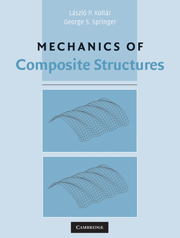Book contents
- Frontmatter
- Contents
- Preface
- List of Symbols
- 1 Introduction
- 2 Displacements, Strains, and Stresses
- 3 Laminated Composites
- 4 Thin Plates
- 5 Sandwich Plates
- 6 Beams
- 7 Beams with Shear Deformation
- 8 Shells
- 9 Finite Element Analysis
- 10 Failure Criteria
- 11 Micromechanics
- Appendix A Cross-Sectional Properties of Thin-Walled Composite Beams
- Appendix B Buckling Loads and Natural Frequencies of Orthotropic Beams with Shear Deformation
- Appendix C Typical Material Properties
- Index
8 - Shells
Published online by Cambridge University Press: 01 September 2009
- Frontmatter
- Contents
- Preface
- List of Symbols
- 1 Introduction
- 2 Displacements, Strains, and Stresses
- 3 Laminated Composites
- 4 Thin Plates
- 5 Sandwich Plates
- 6 Beams
- 7 Beams with Shear Deformation
- 8 Shells
- 9 Finite Element Analysis
- 10 Failure Criteria
- 11 Micromechanics
- Appendix A Cross-Sectional Properties of Thin-Walled Composite Beams
- Appendix B Buckling Loads and Natural Frequencies of Orthotropic Beams with Shear Deformation
- Appendix C Typical Material Properties
- Index
Summary
In this chapter we consider thin composite shells, which we analyze on the basis of the main assumptions employed in the theory of thin plates. However, there is a major difference in the behavior of plates and shells subjected to external loads. Plates resist transverse loads by bending and by transverse shear forces. On the other hand, thin shells resist the transverse loads mostly by membrane forces, which, at any given point, are in the plane tangential to the reference surface (Fig. 8.1). These membrane forces are determined by the “membrane theory of shells,” which neglects bending moments. The resulting stresses, strains, and deformations are reasonable except near supports and in the vicinities of abrupt changes in loads. For thick shells (whose thickness is comparable to the radii of curvature) or when regions near supports or concentrated loads are of interest, more complex analytical solutions or finite element methods must be employed. The decision as to which method to use rests with the individual and depends on his or her experience with analytical solutions and finite element calculations.
Herein we treat thin shells whose thickness h is small compared with all other dimensions and with the radii of curvatures (Fig. 8.2).
- Type
- Chapter
- Information
- Mechanics of Composite Structures , pp. 365 - 394Publisher: Cambridge University PressPrint publication year: 2003



